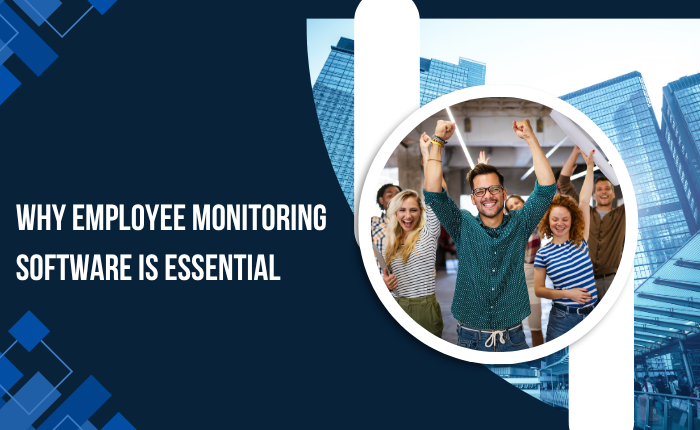Effective employee management depends on clear insights into how work gets done. Whether teams operate remotely, in a hybrid setup, or fully on-site, businesses need tools that provide transparency and support productivity. Employee monitoring software offers precisely way to understand daily workflows, measure performance, and protect sensitive information without unnecessary guesswork.
Beyond simple oversight, this software creates an environment where employees and managers share accountability based on real data. It helps build trust, promotes open communication, and aligns efforts with organizational goals. This post dives into how employee monitoring software functions, why it matters, and the advantages it delivers for modern companies.
Detect Signs Of Overwork And Fatigue
While it’s commonly used to identify dips in productivity, employee monitoring software is just as effective at highlighting when employees are overextending themselves. Patterns such as extended work hours, minimal breaks, and repetitiveness in tasks could be red flags for burnout.
Managers can use this data to intervene early, rebalancing workloads, offering wellness support, or encouraging PTO, to preserve performance and promote healthier work habits across teams.
Promote A Culture Of Responsibility
Accountability thrives on transparency. With employee monitoring software, performance reviews no longer rely on assumptions or subjective observations. Instead, employees and managers can refer to concrete, time-stamped activity reports during one-on-one meetings or evaluations.
This reinforces mutual responsibility, helps employees take ownership of their work, and leads to fairer assessments and more productive coaching conversations.
Manage Remote And Hybrid Teams More Efficiently
Remote and hybrid work models introduce layers of complexity that traditional management practices can’t always navigate. With Such software, businesses maintain visibility into distributed workflows, regardless of time zones or physical locations.
Real-time dashboards, login activity, and task-specific tracking provide structure to operations. It helps ensure consistency in performance, even when employees are working autonomously from different parts of the world.
Prevent Internal Threats And Data Leaks
Digital security threats aren’t limited to external hackers. Insider threats—whether intentional or accidental—pose significant risks. Employee monitoring software offers a proactive defense strategy by:
- Monitoring file transfers and document access
- Flagging the use of unauthorized software
- Tracking USB device activity
- Alerting on suspicious login behavior
With built-in alerts and comprehensive logs, IT teams can detect issues early and act before serious damage occurs.
Monitoring Application and Website Usage
Misaligned tech usage can cause productivity leaks that go unnoticed. It records which applications and websites are being used and for how long, providing clarity into whether tools are being used efficiently.
For example:
- Is too much time spent in internal chat apps vs. project platforms?
- Are outdated or redundant tools still being accessed frequently?
- Is personal browsing creeping into work hours?
These insights inform decisions about tool adoption, training needs, and workplace policies.
Supporting New Hires During Onboarding
The first few weeks of a new hire’s journey are critical. In remote settings, however, it can be difficult to determine how well someone is adapting. Employee monitoring software assists by revealing how new employees interact with onboarding materials, tools, and assigned tasks.
If someone is revisiting the same documents repeatedly or taking longer to complete basic activities, managers can step in with additional support. This ensures a smoother and faster onboarding experience, reducing ramp-up time.
Ensuring Privacy and Building Trust
Adopting such software doesn’t have to feel intrusive. When introduced transparently, with clear communication and privacy policies in place, it becomes a trust-building tool rather than a surveillance method.
Key practices include:
- Clearly defining what is being monitored
- Explaining the purpose behind the tracking
- Communicating the mutual benefits
- Ensuring legal compliance in every jurisdiction
Respectful implementation helps build a more honest and engaged workforce.
Automating Oversight to Save Time
Manual supervision and reporting can overwhelm management teams. Today’s employee monitoring software often includes automation features that simplify operations and reduce administrative burdens.
Some common automations include:
- Scheduled productivity and attendance reports
- Rule-based alerts for security breaches
- Integration with HR and payroll systems
- Enforced usage controls for apps and file access
This lets managers focus on strategy and mentorship rather than daily oversight tasks.
Enhancing Communication and Transparency
Effective communication begins with shared understanding. When everyone has access to the same performance data, conversations become more focused and productive. It supports this by offering clear visibility into workload distribution, time management, and application usage.
Some platforms even allow employees to view their own activity dashboards. This encourages self-correction and promotes a sense of ownership over one’s work habits.
Over time, it strengthens alignment between personal productivity and team goals.
Reducing Compliance Risks
Regulatory compliance is becoming a top priority, particularly in industries that handle customer data, financial records, or sensitive intellectual property. Employee monitoring software, such as EmpMonitor, plays a crucial role in enforcing digital behaviour that aligns with these standards.
From capturing keystroke logs and generating audit trails to detecting policy violations in real-time, it adds an extra layer of accountability, helping businesses avoid penalties associated with non-compliance.
Identifying Workflow Bottlenecks
Time-tracking and activity-monitoring features aren’t just for individual assessment—they also help pinpoint inefficiencies across teams or departments. Are certain tasks consistently taking too long? Is there a recurring delay between dependencies?
Employee monitoring software provides a comprehensive view of work patterns, identifying areas where support, training, or process improvements are needed to enhance productivity.
Conclusion
The workplace is evolving, and so are the tools we need to manage it. Employee monitoring tool is no longer a luxury or a threat; it’s a strategic asset. When implemented with clarity, fairness, and employee well-being in mind, it helps organizations unlock real value from their most important resource: their people.
From better security and compliance to smarter management and team accountability, the benefits are clear. As businesses navigate hybrid work models and increasingly digital workflows, investing in the right employee monitoring software can make all the difference in achieving sustainable success.
FAQs
1. How does employee monitoring software impact employee morale?
When implemented transparently and fairly, it can improve morale by providing clear expectations and recognizing top performers. However, if used secretly or punitively, it may lead to distrust. Communication and policy clarity are key to maintaining positive workplace culture.
2. Can employee monitoring software integrate with other business tools?
Yes, many software solutions integrate with HR systems, project management tools, payroll platforms, and communication apps. This integration helps streamline workflows and makes it easier to analyze productivity alongside other business metrics.



